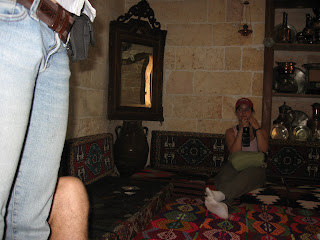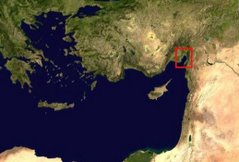Last weekend, we all piled into our trusty dolmuşes and headed east.
Our first stop was Tilman Hoyuk, a site located only a few kilometers from Zincirli which we visited a couple of days earlier.
Our first stop was Tilman Hoyuk, a site located only a few kilometers from Zincirli which we visited a couple of days earlier.

The preservation at Tilman Hoyuk is astonishing. Below is a picture of the site as it looks today. This portion of the site has not been excavated or conserved at all, yet you can still see several stone blocks left standing in place at doorway thresholds.

Our next stop was Yesemek, on which Amanda gave a short presentation. In the past, Yesemek was a stone quarrying and stone working site. Archaeologists working there have found statues representing nearly every stage of production from extraction to near completion. The picture below shows a representative portion of the site, which was covered in half finished status of all sorts of subjects. I believe these are sphinxes.

These three statues are of ancient twin mountain gods.

The actual quarry was further up the mountain. As intrepid archaeologists we just had to go all the way to the top. The picture below shows what the ancient quarry looks like. It is not very much like our modern day quarries which can eat away entire mountains, but more of an opportunistic exploitation of readily available material. If you look closely at the rock in the center of the picture, you can see that it was left after someone had already started carving.
 Finally, for your own edification, this is what Yesemek looks like from the top of the mountain. If you squint and look in the parking lot, you can see one of our vans.
Finally, for your own edification, this is what Yesemek looks like from the top of the mountain. If you squint and look in the parking lot, you can see one of our vans. Next, we stopped in the city of Kilis to look briefly at some Ottoman architecture.
Next, we stopped in the city of Kilis to look briefly at some Ottoman architecture. Following this, we left to go to the famous ancient city of Karchemish. This site nowadays straddles the Turkey-Syrian border at an international crossing, and is inaccessible to civilians. However, when we were asking for directions in the neighboring village, we met a local man who took us to a cemetery which overlooks the site. Due to the sensitivity of the site, though, we still refrained from taking pictures. It seems like this is one site you will have to come to Turkey to see for yourselves.
Following this, we left to go to the famous ancient city of Karchemish. This site nowadays straddles the Turkey-Syrian border at an international crossing, and is inaccessible to civilians. However, when we were asking for directions in the neighboring village, we met a local man who took us to a cemetery which overlooks the site. Due to the sensitivity of the site, though, we still refrained from taking pictures. It seems like this is one site you will have to come to Turkey to see for yourselves.When we were on the road to Karchemish, we made a pit stop at a tiny village. Out of all the things I have seen on this trip so far, the architecture in this village tops the list. It is one thing to see an illustration of a mudbrick house from millennia ago, but it is another to see an inhabited one in person.

After thirteen grueling hours of travel in a hot dolmuş, we finally arrived in Birecik. Here is a picture of the group eating kebabs on the banks of the Euphrates River.

The next day, we started with a tour of Birecik. The next several pictures are of the old city walls, some of which have been since turned into habitations.



While we were looking at these walls, we just happened to run into the one man in probably the entire province who finds old houses to turn into museums. He took us to one late Ottoman house he was currently working on refurbishing. The first picture shows the house from the outside. It is the two stories above the shop.
 Its entrance is on the next street over shown below.
Its entrance is on the next street over shown below.  The next several pictures come from inside the house.
The next several pictures come from inside the house. 




 These next pictures were taken from the ruins of a fortification that overlooked the city of Birecik. This first one shows some of the remaining walls with the Euphrates flowing by in the back ground.
These next pictures were taken from the ruins of a fortification that overlooked the city of Birecik. This first one shows some of the remaining walls with the Euphrates flowing by in the back ground. This is the older part of Birecik as seen from the ruins of the castle.
This is the older part of Birecik as seen from the ruins of the castle. After Birecik, we traveled the site of ancient Seleucia, nowadays known as Zeugma. Below is a picture of most of what there is to see there. The damming of the Euphrates River just downstream from the site has caused significant portions of it to be lost beneath the waves of the new lake.
After Birecik, we traveled the site of ancient Seleucia, nowadays known as Zeugma. Below is a picture of most of what there is to see there. The damming of the Euphrates River just downstream from the site has caused significant portions of it to be lost beneath the waves of the new lake. However, archaeologists did manage to execute a few salvage excavations before the waters literally washed over them. They found at Zeugma incredibly well preserved mosaics, which are now stored at Gaziantep Museum which claims to be the world’s largest mosaic museum. Below is a picture from the museum. To the left is a bronze statue of Mars which is close to life-size for a sense of scales
However, archaeologists did manage to execute a few salvage excavations before the waters literally washed over them. They found at Zeugma incredibly well preserved mosaics, which are now stored at Gaziantep Museum which claims to be the world’s largest mosaic museum. Below is a picture from the museum. To the left is a bronze statue of Mars which is close to life-size for a sense of scales
That is all from me for now. Look out for posts from Amanda and Jeff about the status of our survey in the field.


2 comments:
Your trip and photos are absolutely facinating. I have wanted to see these major archeological sites in Turkey. Thank you so much. Ed
We just finished up 2 weeks of archeological trekking from Diyarbakir to malatya Marden sanliurfra gazientep. Several shockingly neglected sites - Gobekli Tepe for instance was under-researched a mess of rock and scaffolding. Museum which is new was outstanding and surprisingly had several of the pillar tops. Same for Nemrut Dagi...Cayonu Harran Aslantepe were fantastic. Tilman hoyuk and tilman Sam' Al or Zinorli hoyuk (I call Cincirli) Doliche, Egil Eskimo kale karakuls Poseidon centered bridge, Uctepe. Overwhelming albeit archaeologically speaking most left in go take cover and leave condition. Beautiful must see area though. Would do it again because who knows how long it will survive. Suspect that age old common archeological thinking was wrong both in dating sites and use and magnitude of sites is wrong based on rock mineral findings.
Post a Comment